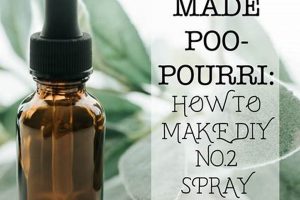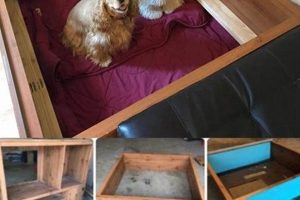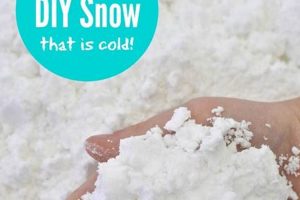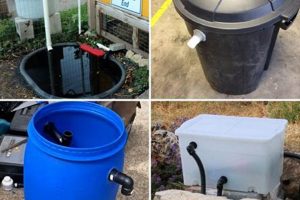Creation of a homemade product designed to remove dead skin cells from the lips constitutes a do-it-yourself lip treatment. This process typically involves combining abrasive agents, such as sugar or salt, with moisturizing ingredients like honey or oil, to formulate a scrub applied to the lips to promote smoothness and reduce dryness. An example includes mixing granulated sugar with coconut oil to create a simple, effective treatment.
The importance of such treatments lies in their ability to improve lip texture, enhance blood circulation, and facilitate better absorption of lip balms and moisturizers. Historically, individuals have utilized natural ingredients available in their households to address skin concerns, reflecting a traditional approach to personal care that precedes commercially manufactured products. This approach enables customized solutions and minimizes reliance on potentially harsh chemicals found in some store-bought alternatives.
The subsequent sections will delve into various formulations, application techniques, safety considerations, and potential benefits associated with crafting and utilizing these personalized lip care solutions.
Expert Guidance on Formulating Lip Exfoliants
The following guidelines offer pertinent advice for individuals considering the formulation and application of homemade lip treatments.
Tip 1: Ingredient Selection: Prioritize the use of fine-grain exfoliants. Coarse particles may cause micro-abrasions on the delicate lip tissue, leading to irritation or damage. Opt for finely ground sugar or sea salt to minimize potential harm.
Tip 2: Hydration is Key: Incorporate humectants and emollients into the formulation. Honey and natural oils, such as coconut, olive, or jojoba, provide both moisturizing and soothing properties, counteracting the drying effects of exfoliation.
Tip 3: Patch Testing: Before full application, conduct a patch test on a small area of skin, such as the inner arm. This allows for the identification of potential allergic reactions or sensitivities to specific ingredients.
Tip 4: Gentle Application: Apply the exfoliant with light, circular motions using a clean fingertip or a soft toothbrush. Excessive pressure can cause irritation and negate the intended benefits.
Tip 5: Limited Frequency: Restrict exfoliation to once or twice weekly. Over-exfoliating can strip the lips of natural oils, leading to dryness, chapping, and increased sensitivity.
Tip 6: Post-Exfoliation Care: Immediately after rinsing off the exfoliant, apply a generous layer of a high-quality lip balm or emollient to replenish moisture and protect the newly exposed skin.
Tip 7: Storage Considerations: If preparing a larger batch, store the mixture in an airtight container in a cool, dry place to prevent bacterial growth and maintain ingredient integrity. Discard any mixture exhibiting signs of spoilage, such as changes in color or odor.
Adherence to these guidelines promotes effective and safe exfoliation, resulting in smoother, healthier lips.
The subsequent section will provide a range of specific formulations and recipes, enabling readers to tailor their lip care regimen to individual needs and preferences.
1. Gentle abrasive selection
The selection of a gentle abrasive is a foundational element within the practice of creating a do-it-yourself lip treatment. The primary function of such treatment is the removal of dead skin cells to reveal smoother, healthier lip tissue. However, lip skin is considerably more delicate than skin on other parts of the body. Therefore, the use of harsh or overly abrasive materials can cause micro-tears, irritation, and inflammation. The effect is counterproductive, leading to chapped, damaged lips rather than the intended improvement. An example of inappropriate abrasive selection would be the use of coarse sea salt, whereas finely ground sugar represents a more appropriate, gentle alternative.
The implementation of gentle abrasives directly influences the efficacy and safety of the lip treatment. Ingredients such as finely ground sugar, oatmeal, or baking soda provide sufficient exfoliation without causing undue harm. These substances effectively slough off dead skin cells, promoting blood circulation, and allowing for better absorption of moisturizing agents subsequently applied to the lips. Furthermore, the integration of a gentle abrasive mitigates the risk of triggering cold sores in individuals prone to such outbreaks. This is a key factor as any trauma to the lip tissue can provoke a recurrence.
In conclusion, the careful selection of a gentle abrasive constitutes a critical aspect of formulating a safe and effective treatment. The utilization of appropriate materials directly impacts the outcome of the treatment, minimizing potential harm and maximizing benefits such as improved lip texture and enhanced hydration. Understanding the importance of this selection allows individuals to craft formulations that are both beneficial and protective for the delicate lip area.
2. Moisturizing base ingredients
The integration of moisturizing base ingredients is intrinsically linked to the successful execution of a homemade lip exfoliation process. Exfoliation, by its very nature, removes the outermost layer of dead skin cells, which can inadvertently strip the lips of their natural oils and moisture. Consequently, the inclusion of moisturizing components becomes not merely beneficial, but essential, to mitigate potential dryness and maintain lip suppleness. For instance, a scrub consisting solely of an abrasive agent, such as sugar, without the addition of a moisturizing agent, such as honey or oil, will likely result in temporary smoothness followed by increased dryness and chapping.
The type of moisturizing base ingredient significantly influences the overall effectiveness and user experience of the treatment. Natural oils, such as coconut, olive, or jojoba, possess emollient properties, forming a protective barrier that seals in moisture and prevents transepidermal water loss. Humectants, such as honey or glycerin, attract moisture from the air and draw it into the skin, providing sustained hydration. The combination of both emollient and humectant ingredients can yield particularly beneficial results. The selection of base ingredients should also consider individual sensitivities and allergies. For example, an individual with a nut allergy should avoid almond oil and opt for alternatives such as shea butter or cocoa butter.
In summary, moisturizing base ingredients are not merely ancillary components of a treatment; they are integral to counteracting the inherent drying effects of exfoliation and ensuring optimal lip health. Careful consideration of ingredient properties and individual needs is crucial for formulating treatments that effectively exfoliate while simultaneously
nourishing and protecting the delicate lip tissue. The absence of adequate moisture replenishment can negate the benefits of exfoliation, potentially exacerbating dryness and damage.
3. Safe ingredient sourcing
The creation of a homemade lip treatment necessitates careful attention to ingredient origin to mitigate potential risks. The act of combining substances for application to the lips, which can be incidentally ingested, introduces a pathway for contaminants and harmful additives to enter the body. Consequently, safe ingredient sourcing is a crucial, non-negotiable element in the formulation of a self-prepared lip treatment, impacting not only the treatment’s efficacy but also the user’s well-being. For example, the use of commercially processed honey containing added sugars or preservatives, versus raw, unfiltered honey from a reputable source, can affect the treatment’s moisturizing properties and introduce unwanted substances. Similarly, the application of oils extracted using harsh chemical solvents may leave residues detrimental to health.
The impact of sourcing extends beyond direct toxicity. The presence of allergens or irritants in seemingly benign ingredients can trigger adverse reactions. Cross-contamination during manufacturing or packaging processes is also a concern. Individuals must exercise due diligence in researching ingredient suppliers, opting for certified organic or food-grade options whenever possible. This includes verifying the absence of pesticides, heavy metals, and other pollutants. Furthermore, the visual inspection of ingredients for discoloration, unusual odors, or other signs of spoilage is essential prior to their incorporation into the formula. Transparent labeling practices and traceability mechanisms implemented by suppliers contribute significantly to consumer confidence and mitigate risks associated with unknown contaminants.
In conclusion, the significance of safe ingredient sourcing within the context of homemade lip treatments cannot be overstated. It represents a proactive approach to minimizing potential harm and maximizing the intended benefits. Prioritizing ingredient quality, transparency, and safety protocols ensures that the final product is not only effective but also safe for topical application and incidental ingestion, aligning with the broader goals of promoting health and well-being through personalized skincare practices.
4. Appropriate application technique
The efficacy of a homemade lip treatment is significantly influenced by the method of application. A carefully formulated mixture can yield suboptimal or even detrimental results if not applied using a proper technique. In the context of do-it-yourself lip treatments, inappropriate application can cause irritation, inflammation, or even damage to the delicate lip tissue, thereby negating the intended benefits of exfoliation. An example of this is the application of a scrub with excessive force, leading to micro-abrasions and increased sensitivity. Conversely, insufficient application may fail to adequately remove dead skin cells, rendering the treatment ineffective.
The primary consideration within application technique is the application of gentle, circular motions. These motions facilitate the exfoliation process without applying undue pressure. Furthermore, the duration of application plays a crucial role. Prolonged rubbing can cause irritation, while an insufficient duration may not yield the desired outcome. A typical application should last between 30 to 60 seconds. The selection of an application tool also influences the overall outcome. A clean fingertip or a soft toothbrush is generally recommended over abrasive cloths or brushes. Post-application, thorough rinsing with lukewarm water is essential to remove any remaining scrub particles, preventing further irritation.
In summary, appropriate application technique is not merely a supplementary step within the treatment; it is an integral component that determines its overall success and safety. Neglecting this aspect can lead to adverse effects, while adherence to proper techniques maximizes the benefits of exfoliation, resulting in smoother, healthier lips. Understanding the interplay between formulation and application is key to achieving the desired outcome when engaging in homemade lip care practices.
5. Hydration post-exfoliation
The practice of lip exfoliation, particularly within the realm of do-it-yourself approaches, necessitates a concurrent focus on post-exfoliation hydration. Exfoliation inherently removes the outermost layer of skin, disrupting the skin’s natural barrier and increasing transepidermal water loss. Therefore, adequate hydration post-exfoliation is not merely a supplemental step, but a critical component in restoring and maintaining lip health. The following points outline key facets of this relationship.
- Replenishing Moisture Barrier
Following exfoliation, the lips are more susceptible to environmental aggressors and moisture loss. The immediate application of a moisturizing agent, such as a lip balm or oil, is essential to replenish the disrupted lipid barrier and prevent dryness. This action mimics the skin’s natural function, protecting underlying tissue and supporting healing. Without this step, exfoliation can paradoxically lead to increased chapping and discomfort.
- Enhancing Product Absorption
Exfoliation removes dead skin cells, creating a smoother surface and enhancing the penetration of subsequently applied moisturizing products. This allows for deeper and more effective hydration, maximizing the benefits of lip balms and treatments. For instance, applying a hydrating serum immediately after exfoliation allows the active ingredients to penetrate more effectively than if applied to a surface covered with dead skin.
- Selecting Appropriate Hydrating Agents
The choice of hydrating agent is crucial. Emollients, such as shea butter or cocoa butter, create a protective barrier, while humectants, such as honey or glycerin, attract moisture from the air. The use of occlusive agents, like beeswax, can further prevent water loss. The specific needs of the individual should guide the selection; drier lips may benefit from a richer, more occlusive formula, while those prone to oiliness may prefer a lighter, humectant-based product.
- Frequency of Reapplication
A single application of a hydrating agent after exfoliation may not be sufficient to maintain adequate moisture levels, especially in dry or cold environments. Regular reapplication throughout the day is essential to combat ongoing water loss and preserve lip suppleness. The frequency of reapplication should be adjusted based on individual needs and environmental conditions, with more frequent applications recommended during periods of increased dryness.
In conclusion, the success of any do-it-yourself lip exfoliation endeavor hinges significantly on the implementation of a diligent post-exfoliation hydration routine. By understanding and addressing the increased susceptibility to moisture loss and selecting appropriate hydrating agents, individ
uals can optimize the benefits of exfoliation and maintain healthy, hydrated lips. The failure to prioritize this aspect can compromise the overall outcome and potentially exacerbate existing lip conditions.
6. Limited usage frequency
The concept of “limited usage frequency” holds significant relevance in the context of “lip exfoliator diy.” Excessive or overly frequent exfoliation of the lips, while seemingly beneficial, can lead to adverse effects that undermine the intended outcome. The delicate nature of lip tissue necessitates a cautious approach to exfoliation, and adherence to recommended usage intervals is crucial for maintaining lip health.
- Disruption of the Natural Lipid Barrier
Lip skin possesses a limited natural lipid barrier, which protects against environmental aggressors and prevents moisture loss. Frequent exfoliation can strip this barrier, leaving the lips vulnerable to dryness, chapping, and irritation. For example, exfoliating daily, rather than once or twice a week, may result in chronic inflammation and heightened sensitivity to external factors, such as cold weather or sun exposure. The implications include impaired barrier function and increased susceptibility to damage.
- Increased Risk of Irritation and Inflammation
Over-exfoliation can cause micro-abrasions on the lip surface, leading to inflammation and discomfort. This is particularly relevant for individuals with sensitive skin or pre-existing conditions such as eczema. The frequent removal of surface cells disrupts the natural healing process, potentially triggering inflammatory responses. A practical example is the development of redness, burning sensations, or peeling after repeated exfoliation within a short period. The impact is magnified when combined with harsh abrasive agents.
- Impaired Healing and Regeneration
The natural turnover rate of lip skin cells is relatively slow. Over-exfoliation disrupts this cycle, hindering the skin’s ability to regenerate and repair itself. Repeated removal of immature cells before they fully differentiate can lead to impaired barrier function and increased susceptibility to damage. For instance, exfoliating more than twice a week might prevent the full maturation of new skin cells, resulting in a weaker and more vulnerable lip surface. The consequence is delayed healing and a compromised skin structure.
- Potential for Hyperpigmentation or Hypopigmentation
In certain individuals, excessive exfoliation can trigger changes in pigmentation. Repeated trauma to the lip skin may stimulate melanocyte activity, leading to hyperpigmentation (darkening) or, conversely, disrupt melanin production, resulting in hypopigmentation (lightening). An example includes the development of dark spots or uneven skin tone after prolonged over-exfoliation. The implications are aesthetic concerns and potential long-term changes in lip color.
The components of limited usage frequency, ranging from disruption of the lipid barrier to alterations in pigmentation, underscore the importance of moderation in “lip exfoliator diy.” Understanding the potential consequences of over-exfoliation enables informed decisions regarding treatment frequency, thereby promoting lip health and preventing adverse reactions. Adherence to a judicious exfoliation schedule is essential for maximizing benefits while minimizing risks.
7. Proper storage practices
Formulated lip treatments intended for do-it-yourself application are susceptible to degradation and contamination if not stored under appropriate conditions. The interaction between ingredients, particularly natural compounds, and environmental factors such as temperature, light, and humidity, can significantly alter product efficacy and safety. Microbial proliferation within the mixture poses a direct threat, leading to potential infections or adverse reactions upon application. For example, a scrub containing honey, stored at room temperature and exposed to moisture, provides an ideal medium for bacterial growth, potentially causing irritation or infection when applied to the lips. Consequently, adherence to proper storage protocols represents a critical element within the overall DIY lip care process.
Implementation of appropriate storage methods extends beyond simple containment. Mixtures should be stored in airtight containers, preferably made of non-reactive materials such as glass or food-grade plastic, to prevent oxidation and chemical leaching. Exposure to direct sunlight and extreme temperatures should be avoided, as these conditions accelerate degradation and can alter the physical properties of the mixture. Furthermore, labeling the container with the date of preparation is essential for tracking product freshness and ensuring timely disposal. In instances where refrigeration is recommended, the impact on viscosity and texture should be considered, and the mixture allowed to return to room temperature before application. Improper storage not only diminishes the treatment’s effectiveness but also introduces the risk of allergic reactions or skin irritation due to altered ingredient composition.
The implementation of proper storage practices directly impacts the safety, efficacy, and longevity of homemade lip treatments. Neglecting these guidelines can negate the benefits of carefully selected ingredients and render the final product potentially harmful. Therefore, understanding and adhering to recommended storage protocols is paramount for individuals engaging in do-it-yourself lip care, ensuring a safe and beneficial experience. The adherence to proper storage practices directly corresponds to the effective mitigation of risks, thereby safeguarding the well-being of the user.
Frequently Asked Questions Regarding DIY Lip Exfoliation
This section addresses common inquiries concerning the formulation, application, and safety of homemade lip treatments, offering clarity and guidance on best practices.
Question 1: What constitutes the ideal frequency for lip exfoliation treatments?
The recommended frequency is limited to one to two times per week. More frequent exfoliation can disrupt the natural lipid barrier of the lips, leading to dryness and irritation.
Question 2: Are there specific ingredients to avoid when creating a homemade lip scrub?
Harsh abrasives, such as coarse salt or large sugar crystals, should be avoided as they can cause micro-tears in the delicate lip tissue. Additionally, ingredients known to be common allergens or irritants should be excluded.
Question 3: How does one ascertain potential allergic reactions to ingredients before applying a homemade lip scrub?
A patch test is recommended prior to full application. Apply a small amount of the scrub to a discreet area of skin, such as the inner arm, and observe for any signs of irritation or allergic reaction over a 24-hour period.
Question 4: What post-exfoliation care is essential for maintaining lip health?
Following exfoliation, immediate application of a moisturizing lip balm or oil is crucial to replenish lost moisture and protect the newly exposed skin from environmental factors.
Question 5: Can homemade lip scrubs be safely stored for extended periods?
Storage duration is contingent on the ingredients used and storage conditions. Generally, homemade scrubs should be stored in airtight containers in a cool, dry place and discarded after one week to minimize the risk of bacterial contamination.
Question 6: Is it necessary to use a lip scrub, or are there alternative methods for addressing dry, flaky lips?
While lip scrubs can be effective, gentle alternatives include applying a thick layer of lip balm overnight or using a soft toothbrush to gently massage the lips after showering.
Understanding these frequently asked questions facilitates informed decision-making regarding the implementation of homemade lip treatments, promoting safe and effective practices.
The subsequent section will delve into specific formulations and recipes for do-it-yourself lip scrubs, providing practical guidance for creating personalized lip care solutions.
Conclusion
The preceding discussion has provided a comprehensive overview of lip exfoliator diy, encompassing formulation guidelines, safety considerations, application techniques, and proper storage practices. Key elements identified as crucial for success include gentle abrasive selection, moisturizing base ingredients, safe ingredient sourcing, appropriate application, hydration post-exfoliation, limited usage frequency, and proper storage practices. Adherence to these principles maximizes the benefits while minimizing potential risks associated with homemade lip treatments.
The practice of creating personalized lip care solutions offers a viable alternative to commercially available products, enabling customization and control over ingredient composition. However, diligent attention to detail and adherence to established guidelines are paramount. The information presented serves as a foundation for informed decision-making and responsible implementation, ultimately contributing to improved lip health and well-being.







